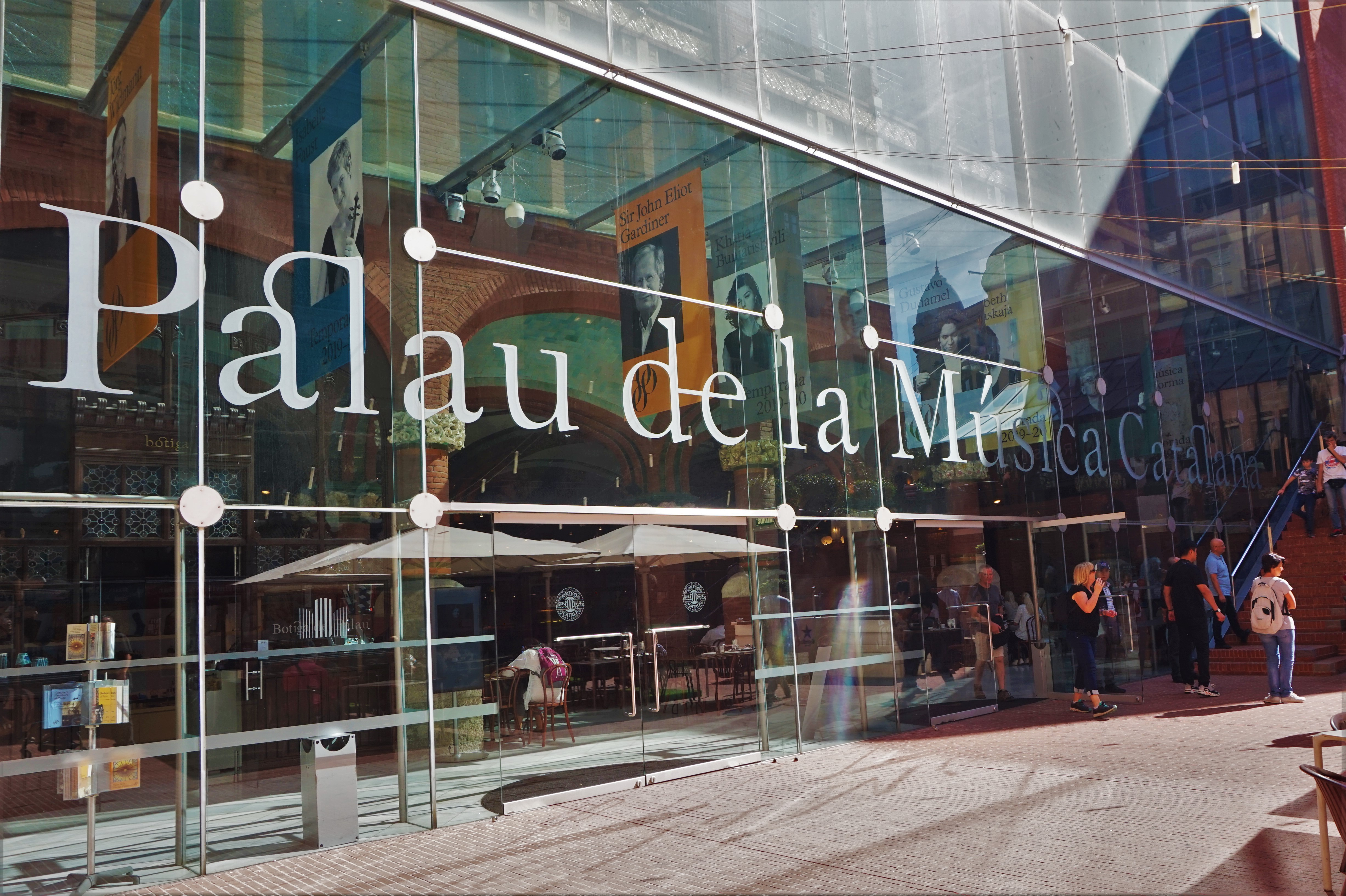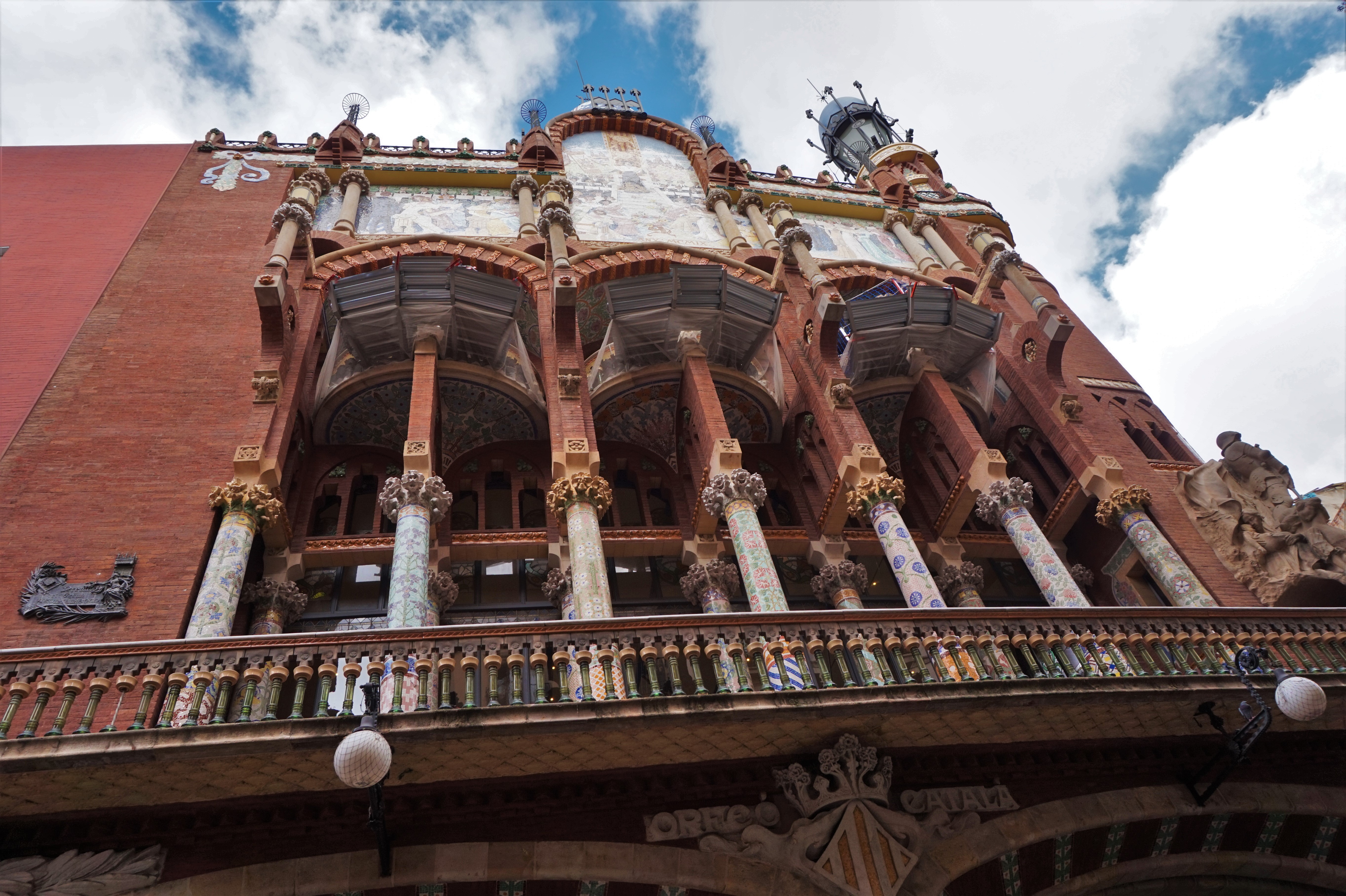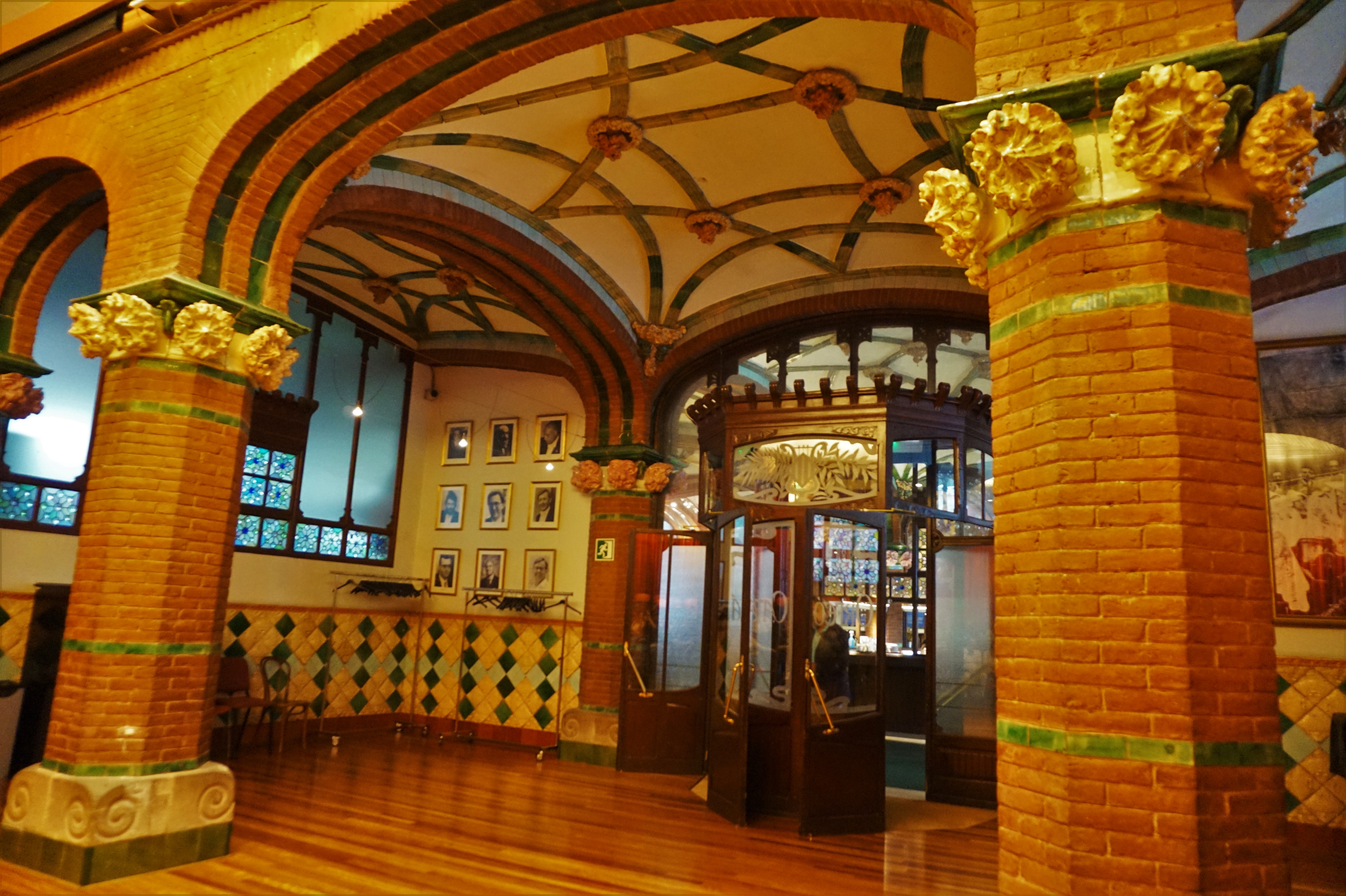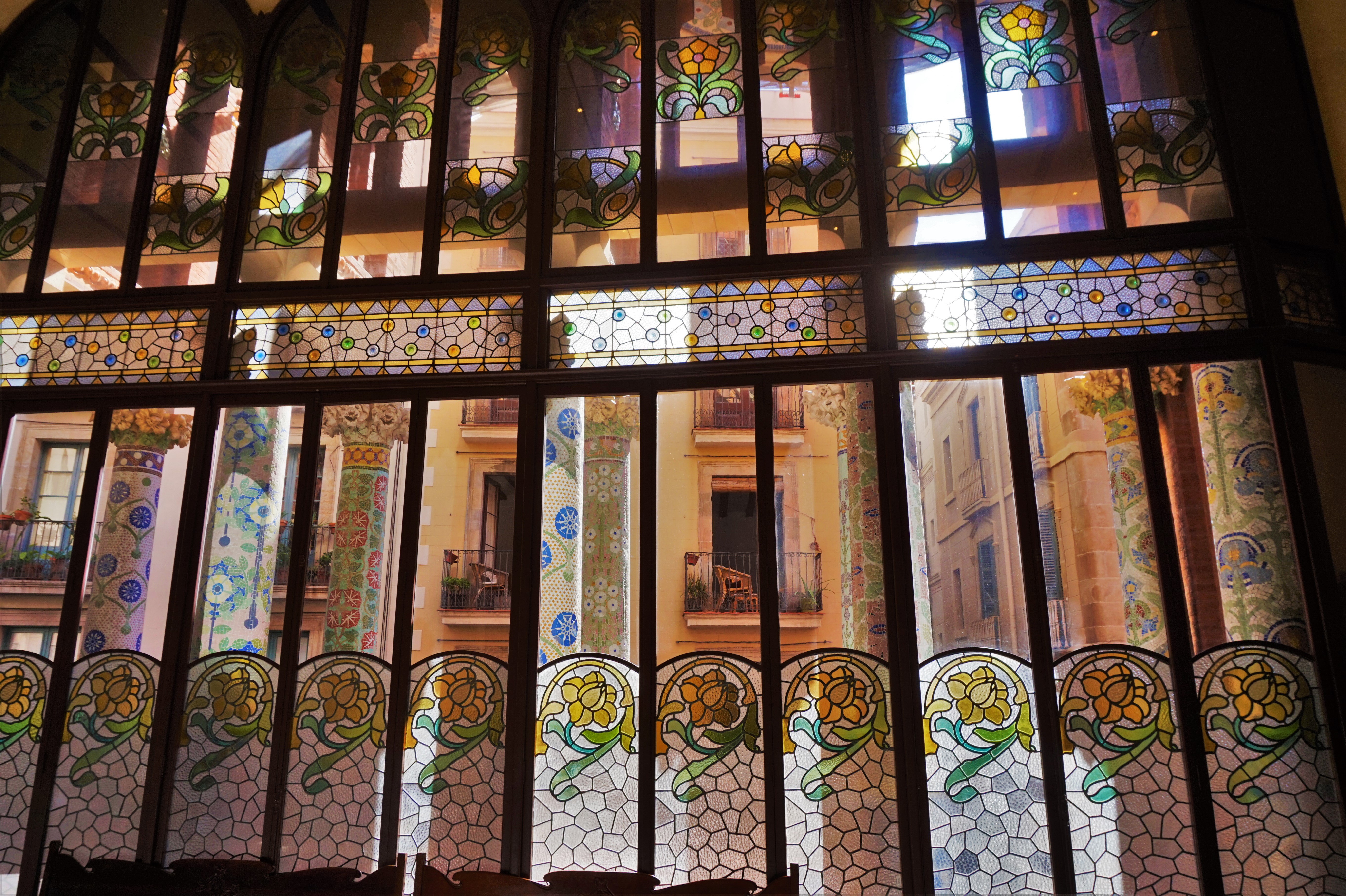[SPAIN] Barcelona - Palau de la Musica Catalana

Palau de la Música Catalana, a concert hall that epitomises Catalan Art Nouveau, was designed by Lluís Domènech i Montaner. It was built during 1905 to 1908 for a choral group named Orfeó Catalá. It was declared by UNESCO as a World Heritage Site in 1997. Although it is still a fully functioning music hall today, it is equally as popular as a tourist attraction with guided tours to view its distinctive and ornamental interior.
The building is located in Sant Pere district, in the northern part of the Barcelona old town.
The richly decorated façade is adorned with mosaic-decorated columns, each of which has a different floral pattern. Combination of various elements as well as different architectural styles such as sculptures, blacksmithing, ceramics and stained glass can be seen clearly at Palau de la Música Catalana. The former ticket box is located in the center column.
The massive sculpture at one corner is dedicated to the Catalan song and dominated by the patron saint of Catalonia, Sant Jordi.
Today, visitors generally enter the Palau through the foyer which was created during the renovations in 1980’s. The foyer features a café which is open from 9 a.m. to midnight from Monday to Sunday. Glazed green, pink, and yellow ceramic flowers on the wide exposed brick arches recapitulate the ornamentation of the rest of building.
* No food or drink of any kind is allowed in the performance hall.
Visitors of guided tour will be first brought to Rehearsal Hall of the Orfeó Català where the tour guide will briefly explain the rules and regulations as well as the history of the building.
This is the first stone of the Palau, which was laid here in 1905.
The grand marble staircase brings visitors to the second floor. The balustrades of the staircases, also marble, are supported by unusual transparent yellow glass balusters.
Next, the tour guide led us directly to the Concert Hall, the largest and most impressive hall. The Concert Hall, which seats about 2,200 people, is the only auditorium in Europe that is illuminated during daylight hours entirely by natural light.
The natural light mainly filter through the central skylight portraying the sun and the glass walls surrounding the hall. The inverted dome of the skylight in shades of gold surrounded by blue that suggests the sun and the sky.
The central stage is dominated by the organ above.
There are sculptures of 16 muses playing different musical instruments from different countries and regions on both sides of the wall. Only the upper bodies of the muses protrude from the wall, their lower bodies are depicted by colorful mosaics that form part of the wall. They symbolize the different musical styles and embody the spirit of the Palau de la Música Catalana - a performance venue where every musical genre should find its place.
The imposing sculptures to the left of the stage represents folk music while the right one represents classical music. Both are united at the top of the arch.
Looking from the upper hall.
The sculptures of winged horses in the upper balcony are in honour of Pegasus, the horse of Greek mythology and the symbol of high-flying imagination.
The natural motifs, including flowers, palms or fruits, give the Concert Hall the appearance of a garden filled with lush flowers and plants.


In each of the vaults between the pillars and the glass walls, there is a white tile medallion, bordered with laurel green leaves, with the names of notable musicians such as Palestrina, J.S. Bach, Carissimi, Beethoven and Chopin to the left and Victoria, Handel, Mozart, Gluck and Wagner to the right.
It really felt like I was in a giant music box.
The last venue is the Lluís Millet Hall. It is a meeting place in intermissions dedicated to Maestro Millet, the founder of the Orfeó Català. The hall is two storeys high. The big stained-glass doors decorated with floral designs opens to a beautiful balcony.
The double colonnade on the balcony are decorated with colourful mosaic, each with its own design.
The expansion of the Palau in the 1980’s, supervised by the architect Òscar Tusquets, has made the entire exterior wall at the side visible and protected by the glass. The project also created a new 600-seater underground auditorium, the "Petit Palau", and a restaurant, "El Mirador del Palau".
Many of the world's best soloists, singers and choirs have performed the Palau de la Música Catalana and many great orchestras and conductors have also played at the auditorium. For some years, plays were performed there.
Even if you're not a fan of classical music, it is still worth to join the guided tour as you cannot view its stunning interior otherwise. The tours are available in Castellano (Spanish), Catalan, French and English. The English speaking tours take place on an hourly basis and last for approximately fifty minutes. It is advisable to book the tickets of guided tour in advance.

The Palau Square of the Palau de la Musica Catalana. It is worth remembering that you are close to numerous other worthwhile Barcelona spots, eg. Avenida de la Cathedral and Barcelona's cathedral.
Palau de la Música Catalana
Admission: EUR 20 (Adults), EUR 11 (Students and 65+), Free (0-9 years)Opening hours:
Open daily from: 10:00 am - 3:30 pm
Easter and July: 10:00 am - 6:00 pm
August: 9:00 am - 6:00 pm
Official website: https://www.palaumusica.cat/en




































![[MALAYSIA] How To Do A Self Guided Walking Tour in Kota Kinabalu](https://blogger.googleusercontent.com/img/b/R29vZ2xl/AVvXsEgR_cJjX4Shl9rsz0ufzxjmtLMq5PAvmTNDHypSVV2CYDaarZVj8EMznRkXqdVeCGg2yEMdFqPtI5rvrmMtJVSL1W9jqOtdCM2EFAc5ZTWn7XzPQV5sqS4s1DO0T_AuF0nq_dLQ53b9-ju3yyLJUrvU2TlhbmD4rDDV5-aPFaT2WEQZ1c257JXGUhyfsw/s72-c/20220524_131141.jpg)
![[JAPAN] Osaka Universal Studio](https://blogger.googleusercontent.com/img/b/R29vZ2xl/AVvXsEilW88BKY24KkvC4WjRfTktmxFmylxMsDD8emYT93x8bOlgqzMV1feAp28Si_GPn3hyFD2E97CMmP3X6kceDfFa9WB_7qr2BFvmu20iVJRaNlZd1BfoyUUj5ZgofOgK5lZGoqVDS4-1YLTo/s72-c/?imgmax=800)
![[FRANCE] My Favourite Paris Eiffel Tower Photo Spots](https://blogger.googleusercontent.com/img/b/R29vZ2xl/AVvXsEi220KHLfBDpyO53KorHwAb0KQEuiiaVDlrFYwEEAvs8YvKb-Edmyt7Hl7rZszN6qc-GM4e3SmjBS2pUiCiv8ljl8mnrUR93Ljxb0xGrSZ4sZLPRErpbAj29btKvnIC67xV93iKnrH3QRcc/s72-w781-c-h505/DSCF4372.JPG)



![[MONACO] How To Visit Monaco In One Day From Nice](https://blogger.googleusercontent.com/img/b/R29vZ2xl/AVvXsEgZkJeVAOmz4LTRwY2uDTK131UJVUWH_44GUUU3H-ni63dK2BlNqITBIh5Tdcpz9kXTUb7ePW7f-PQ1Y7E6B4lnqKEHs_nL3Eop-ouoFhxayMI4lNCcUG-oJnGMVwpGDlBu8lfgn10H_QHw/s72-c/DSC06605.JPG)
![[MOROCCO] My Day Trip to Blue City of Chefchaouen From Fez](https://blogger.googleusercontent.com/img/b/R29vZ2xl/AVvXsEh-7PIqgkIbF1BtTIOwfZ2R611OUrvV7f4Uxih57is62V_QD_DySCdifgR250MMruySrRmV7UMQ14iRsQZ6ifAaAWTqYacWSu__Lpm6QuqEjUcMZ4IJz-0SLDKeCV-nn6Zk1qbyMtMaZf4YupMArl4gXmmXoQUxHc6T-_eW-X2jvjh47rlu4Ddq4_Q48g/s72-c/DSC07946.JPG)
0 comments: